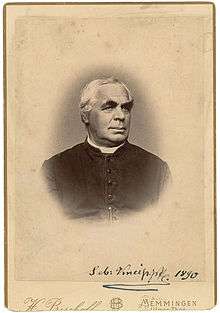Sebastian Kneipp

Sebastian Kneipp (May 17, 1821, Stephansried, Germany – June 17, 1897, in Bad Wörishofen) was a Bavarian priest and one of the forefathers of the naturopathic medicine movement. He is most commonly associated with the "Kneipp Cure" form of hydrotherapy, the application of water through various methods, temperatures and pressures which he claimed to have therapeutic or healing effects.
Although most commonly associated with one area of Nature Cure, Kneipp was the proponent of an entire system of healing which rested on 5 main tenets:[1]
- Hydrotherapy - Kneipp was able to heal many people with water
- Herbalism – The use of botanical medicines was another of Kneipp's specialities
- Exercise - Promoting health of the body through movement
- Nutrition - A wholesome diet of whole grains, fruits & vegetables with limited meat.
- Balance - Kneipp believed that a healthy mind begot a healthy person
History
Kneipp was born in 1821 in Bavaria.[2] His father was a weaver, and Kneipp trained as a weaver until he was 23 when he began training for the priesthood.[2] He fell ill with tuberculosis, and claimed that he was healed by a "water cure" that he read in a book that he found.[2] He was ordained as a Catholic priest in 1852.[2]
In the 19th century, there was a popular revival in the application of hydrotherapy, instigated around 1829 by Vincent Priessnitz, a peasant farmer in Gräfenberg, then part of the Austrian Empire.[3][4] This revival was continued by Kneipp, "an able and enthusiastic follower" of Priessnitz, "whose work he took up where Priessnitz left it",[5] after he came across a treatise on the cold water cure.[6][7] At Worishofen, while serving as the confessor to the monastery, he began offering treatments of hydrotherapy, botanical treatments, exercise and diet to the people who lived in the village.[2] Some of his suggested treatments included "ice cold baths and walking barefoot in the snow" and other "harsh" methodologies.[8] In 1893, M. E. Bottey described Kneipp's water cures as "dangerous in most cases".[9]". Worishofen became known as a place with a reputation for spiritual healing.[2] In addition to "peasants", Kneipp's clients also included Archduke Franz Ferdinand of Austria and his father, Archduke Karl Ludwig as well as Pope Leo XIII.[8] Others took Kneipp's processes back to their home countries to found alternative therapy spas and colleges.[8] In America, Kneipp Societies were founded, which, under the influence of Benedict Lust, changed their name to Naturopatic Society of America.[10]
Kneipp's book My Water Cure was published in 1886 with many subsequent editions, and translated into many languages. He also wrote "Thus Shalt Thou Live", "My Will", and The Care of Children In Sickness and In Health.
In 1891, he founded Kneipp Bund, an organization that promotes water healing to this day.[11]
Kneipp died in 1897.[2]
Legacy
Archduke Josef dedicated his medical atlas to Kneipp.[12] Kneipp's likeness was featured on a stamp.[13] His recipe for whole wheat bread, called Kneippbrød, is the most commonly eaten bread in Norway.[13]
See also
References
- ↑ "Kneipp Philosophy". Kneipp International. Retrieved 3 April 2016.
- 1 2 3 4 5 6 7 Hoolihan, Christopher (2008-11-01). An Annotated Catalogue of the Edward C. Atwater Collection of American Popular Medicine and Health Reform. Volume 3: Authors A-Z. University Rochester Press. pp. 424–5. ISBN 9781580462846. Retrieved 2013-02-05.
- ↑ Claridge, Capt. R.T. (1843). Hydropathy; or The Cold Water Cure, as practiced by Vincent Priessnitz, at Graefenberg, Silesia, Austria. (8th ed.). London: James Madden and Co. Retrieved 2009-10-29. Full text at Internet Archive (archive.org). Note: The "Advertisement", pp.v-xi, appears from the 5th edition onwards, so references to time pertain to 5th edition.
- ↑ Metcalfe, Richard (1898). Life of Vincent Priessnitz, Founder of Hydropathy. London: Simpkin, Marshall, Hamilton, Kent & Co. Retrieved 2009-12-09. Full text at Internet Archive (archive.org).
- ↑ Metcalfe, Richard (1898), p.117
- ↑ Metcalfe, Richard (1898), p.120
- ↑ Kneipp, Sebastian (1891). My Water Cure, As Tested Through More than Thirty Years, and Described for the Healing of Diseases and the Preservation of Health. Edinburgh & London: William Blackwood & Sons. Retrieved 2009-12-03. translation from the 30th German edition. Full text at Internet Archive (archive.org).
- 1 2 3 Sinclair, Marybetts (2007-11-01). Modern Hydrotherapy for the Massage Therapist. Lippincott Williams & Wilkins. pp. 10–. ISBN 9780781792097. Retrieved 2013-02-05.
- ↑ "Minor Paragraphs". Popular Science. Bonnier Corporation. 48 (21): 431–2. January 1896.
- ↑ Wengell, Douglas; Gabriel, Nathen (2008-09-01). Educational Opportunities in Integrative Medicine: The A to Z Healing Arts Guide and Professional Resource Directory. The Hunter Press. pp. 120–. ISBN 9780977655243. Retrieved 2013-02-05.
- ↑ History of Soybeans and Soyfoods in Southeast Asia (13th Century To 2010): Extensively Annotated Bibliography and Sourcebook. Soyinfo Center. 2010-06-01. pp. 768–. ISBN 9781928914303.
- ↑ Skrypzak, Joann; Buenger, Barbara Copeland; Art, Elvehjem Museum of (2003). Design Vienna: 1890s to 1930s. Chazen Museum of Art. pp. 92–. ISBN 9780932900968. Retrieved 2013-02-05.
- 1 2 Skinlo, Inger Helga (2002-10-03). "Kneippbrødets historie" [History of Kneippbrod] (in Norwegian). NRK.
External links
| Wikimedia Commons has media related to Sebastian Kneipp. |
- Works by Sebastian Kneipp at Project Gutenberg
- Works by or about Sebastian Kneipp at Internet Archive
- Kneipp: Wasserkur (Hydrotherapie) (My Water Cure, original, German language, fulltext)
-
 "Kneipp, Sebestian". Encyclopedia Americana. 1920.
"Kneipp, Sebestian". Encyclopedia Americana. 1920. - Digital edition: Mein Testament für Gesunde und Kranke by the University and State Library Düsseldorf